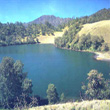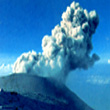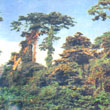|
Survival
Use A Compass
Preperation Checklist
Climbing
Permit
The
Route
Map




|
GENERAL
DESCRIPTION
Location
of Mt.Semeru
Bromo Tengger Semeru National Park is one of conservation
areas which has been already well known by many people, because
it has great values of potential aspects both is viewed from cultural
history, biodiversity and estetica. This is proved with increasing
of people to visit the park with various interests like for recreation,
camping climbing, education and research.
Realizing that situation, the government had established Bromo
Tengger Semeru National Park area as a nasional park which
was established on November 12, 1992 with the decree of Minister
of Foresty No.1049/Kpts-Il/1992 with covering an area of 50.267,3
ha. which administratively is located in 4 regencies of Probolinggo,
Pasuruan, Malang and Lumajang, East Java Pnovince.
Mount Semeru is located between the regencies of Malang and Lumajang
with geographical position of 8 06' South Latitude and 12 55'
East Longitude.
The peak of Mount Semeru is 3,676 m above sea level, the highest
mountain in
Java and one of active volcano.
The Caldera of Mount Semeru is located in the Lumajang Regency
viewed from the South.
Mount Semeru resembles a perpectly cone-form but in fact it is
a dome form with stripefield on hillsides.
Soil
and Climate of Mt.Semeru
Soil in Mount Semeru is regosol as a result of youth quaner volcano.
Generally climate in Mount Semeru area is B type (Schmidt and
Ferguson)
with rainfall of 927 mm-5498 mm per year with the sun of rainy
day is 136 days/year
and wet season is from November to April.
Temperature in the peak of Semeru ranges from 0 - 4 C
Flora
and Fauna of Mt.Semeru
Flora in Semeru area consisted of various species dominated
by Casuarina junghuniana, Acacia decurens, Pinus merkusii and
Podocarpus sp. Understory species are dominated by Euphathorium
odoretum, Imperata cylindrica, Melastomamalabathricum and Anaphalis
javanica.
Fauna spesies can be found in Mount Semeru area like :
Panthera pardus. Presbytis cristata, Paradoxurus hemaproditus,
Muntiacus muntjak and tragulus javanica.
|









